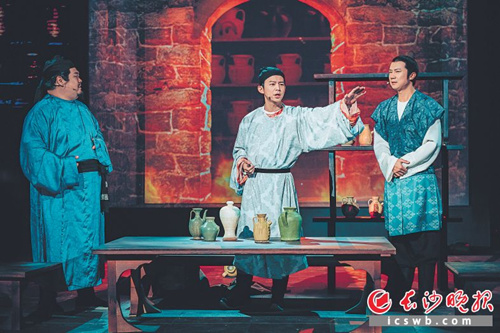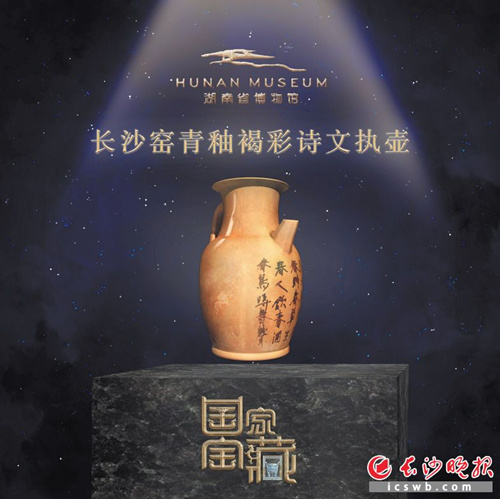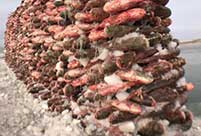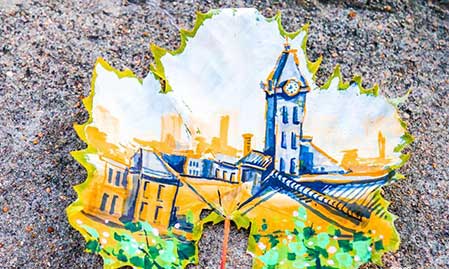


He Jiong, a famous Chinese host of the entertainment program, acts as the owner of a Changsha kiln in the TV show National Treasure. [Photo/icswb.com]
Three national treasures from the Hunan Museum were featured on CCTV 3’s popular cultural program, National Treasure at 7:30pm, Jan 13.
The Min Erquan Fanglei, a silk painting and a brown porcelain ewer etched with poetic designs were selected from thousands of historical pieces for the audience to enjoy.
Entertainers will give insight about these artifacts to the audience throughout the 100 running minutes of the show.
The Min Erquan Fanglei, in Chinese means a fanglei owned by a man named Min Erquan. A fanglei is a type of ancient wine vessel that is aptly described by the two Chinese words it consists of fang which means to be of square shaped and lei, a word used to denote a container of wine during ancient times.
This ancient vessel is from the Shang Dynasty (c.16 century-11th century BC), which was the peak of the Chinese bronze age. What makes this fanglei special is that it has been hailed as the "King of all fangleis" for its varied intricate carvings.
Since its excavation in 1919, the body of the vessel had been long separated from its lid for nearly a century until 2014, when it was brought from overseas and reunited with the other part. It now sits as a part of the Hunan Museum's collection.
Huang Bo and Wang Jia who have been nicknamed the 'Relic Guardians' made this story of reunion come alive by acting out the artifact's history.
The silk painting which was unearthed in 1972 from the Western Han Dynasty (206-25BC) tomb of Lady Xinzhui, the wife of Marquis Li Cang, is perhaps not as famous as some other works of art from the Hunan Museum's collection, such as that of the plain gauze gown and the vermillion coated coffin.
Tang Hao, the show's executive director explained why he chose the beautiful silk painting instead of other more well-known artifacts. "Most museums taking part would like to select their best-known items, such as Hubei Museum did with the Sword of Goujian, and how the Shanghai museum showed us the Dake ding," said Tang Hao. "However, we want to give audience more than what they will expect."
With a length 205cm, a top width of 92cmand a bottom width of 47.7cm, the paintings on the T-shaped silk painting can be categorized into three parts: the heavenly world, the human world and the underworld from the top to bottom, a representation of the romantic real life view of the time.
The last one piece is a Tang Dynasty (618-907) wine pouring utensil decorated with poetry, made by an ancient Changsha Kiln.
"A large number of porcelain products made in Changsha Kilns was exported to Japan, the Middle East and South Asia during the Tang Dynasty, which tells us that that the Hunan people were real pioneers," said Tang as he took away any doubts on why this masterpiece was selected.
Poetry designs were an important feature of porcelain products made in Changsha Kilns during the Tang dynasty. The colloquial poem etched on this ewer describes the season of spring which was a common theme amongst the kiln's poetic etchings.

The brown porcelain ewer etched with poetic designs dating back to Tang Dynasty (618-907) is housed in Hunan Museum, Changsha. [Photo/icswb.com]
The airing of the TV show will hopefully help promote Hunan's culture and history while giving the southern province some global exposure.
Source: Changsha Evening News
 Fishermen build wall with 2,000 fish in Jilin
Fishermen build wall with 2,000 fish in Jilin In pics: Americans in 2017
In pics: Americans in 2017 In pics: Longzhou Danxia landform in NW China
In pics: Longzhou Danxia landform in NW China China's "four great new inventions" in modern times
China's "four great new inventions" in modern times Chinese brand becomes largest handset provider in Africa
Chinese brand becomes largest handset provider in Africa Busty Lais Ribeiro steals the Victoria's Secret Fashion Show
Busty Lais Ribeiro steals the Victoria's Secret Fashion Show Highlights Victoria's Secret Fashion Show in Shanghai
Highlights Victoria's Secret Fashion Show in Shanghai China's first cross-sea rail-road bridge takes shape
China's first cross-sea rail-road bridge takes shape A fancy world painted on fallen leaves
A fancy world painted on fallen leaves Top 10 most sustainable cities in China
Top 10 most sustainable cities in China Top 10 European patent applicants in 2016
Top 10 European patent applicants in 2016 The power of 'She' in China
The power of 'She' in China Seven most beautiful art museums in China
Seven most beautiful art museums in China Law decides if Chow Ting can contest election
Law decides if Chow Ting can contest election
 Xi’s book on governance republished amid worldwide demand
Xi’s book on governance republished amid worldwide demand
 Bollywood superstar Aamir Khan softens Sino-India communications
Bollywood superstar Aamir Khan softens Sino-India communications The gas geezer
The gas geezerDay|Week